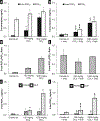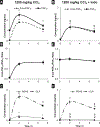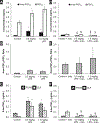Reinterpreting the best biomarker of oxidative stress: The 8-iso-prostaglandin F2α/prostaglandin F2α ratio shows complex origins of lipid peroxidation biomarkers in animal models
- PMID: 26964509
- PMCID: PMC6626672
- DOI: 10.1016/j.freeradbiomed.2016.03.001
Reinterpreting the best biomarker of oxidative stress: The 8-iso-prostaglandin F2α/prostaglandin F2α ratio shows complex origins of lipid peroxidation biomarkers in animal models
Abstract
Oxidative stress is elevated in numerous environmental exposures and diseases. Millions of dollars have been spent to try to ameliorate this damaging process using anti-oxidant therapies. Currently, the best accepted biomarker of oxidative stress is the lipid oxidation product 8-iso-prostaglandin F2α (8-iso-PGF2α), which has been measured in over a thousand human and animal studies. 8-iso-PGF2α generation has been exclusively attributed to nonenzymatic chemical lipid peroxidation (CLP). However, 8-iso-PGF2α can also be produced enzymatically by prostaglandin-endoperoxide synthases (PGHS) in vivo. When failing to account for PGHS-dependent generation, 8-iso-PGF2α cannot be interpreted as a selective biomarker of oxidative stress. We investigated the formation of 8-iso-PGF2α in rats exposed to carbon tetrachloride (CCl4) or lipopolysaccharide (LPS) using the 8-iso-PGF2α/PGF2α ratio to quantitatively determine the source(s) of 8-iso-PGF2α. Upon exposure to a 120mg/kg dose of CCl4, the contribution of CLP accounted for only 55.6±19.4% of measured 8-iso-PGF2α, whereas in the 1200mg/kg dose, CLP was the predominant source of 8-iso-PGF2α (86.6±8.0% of total). In contrast to CCl4, exposure to 0.5mg/kg LPS was characterized by a significant increase in both the contribution of PGHS (59.5±7.0) and CLP (40.5±14.0%). In conclusion, significant generation of 8-iso-PGF2α occurs through enzymatic as well as chemical lipid peroxidation. The distribution of the contribution is dependent on the exposure agent as well as the dose. The 8-iso-PGF2α/PGF2α ratio accurately determines the source of 8-iso-PGF2α and provides an absolute measure of oxidative stress in vivo.
Keywords: 8-iso-PGF(2α)/PGF(2α) ratio; Biomarkers; F(2)-isoprostanes; Inflammation; Lipid peroxidation; Oxidative stress.
Copyright © 2016. Published by Elsevier Inc.
Figures




References
-
- Valko M; Rhodes CJ; Moncol J; Izakovic M; Mazur M Free radicals, metals and antioxidants in oxidative stress-induced cancer. Chem. Biol. Interact 160:1–40; 2006. - PubMed
-
- Kamp DW; Graceffa P; Pryor WA; Weitzman SA The role of free radicals in asbestos-induced diseases. Free Radic. Biol. Med 12:293–315; 1992. - PubMed
-
- Kadiiska MB; Gladen BC; Baird DD; Germolec D; Graham LB; Parker CE; Nyska A; Wachsman JT; Ames BN; Basu S; Brot N; Fitzgerald GA; Floyd RA; George M; Heinecke JW; Hatch GE; Hensley K; Lawson JA; Marnett LJ; Morrow JD; Murray DM; Plastaras J; Roberts LJ II; Rokach J; Shigenaga MK; Sohal RS; Sun J; Tice RR; Van Thiel DH; Wellner D; Walter PB; Tomer KB; Mason RP; Barrett JC Biomarkers of oxidative stress study II: are oxidation products of lipids, proteins, and DNA markers of CCl4 poisoning? Free Radic. Biol. Med 38:698–710; 2005. - PubMed
Publication types
MeSH terms
Substances
Grants and funding
LinkOut - more resources
Full Text Sources
Other Literature Sources
Miscellaneous

